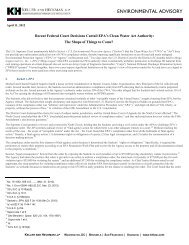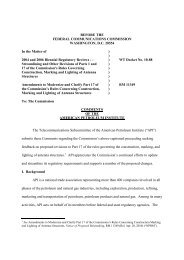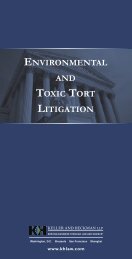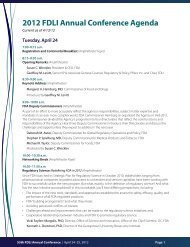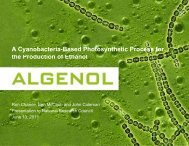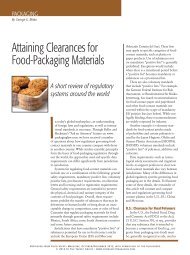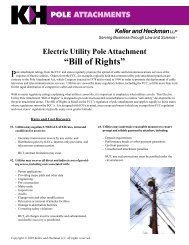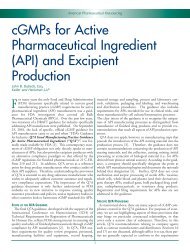A Practical Understanding of the Polymer ... - Keller Heckman
A Practical Understanding of the Polymer ... - Keller Heckman
A Practical Understanding of the Polymer ... - Keller Heckman
You also want an ePaper? Increase the reach of your titles
YUMPU automatically turns print PDFs into web optimized ePapers that Google loves.
<strong>Polymer</strong> Exemption Requirements<br />
5. (d)(5); High Molecular Weight, Water-Absorbing <strong>Polymer</strong>s<br />
This provision excludes certain water-absorbing polymers from eligibility for<br />
<strong>the</strong> amended polymer exemption. A water-absorbing polymer is defined as one<br />
“that is capable <strong>of</strong> absorbing its own weight <strong>of</strong> water” and has a number-average<br />
molecular weight (NAMW) equal to or greater than 10,000. 8/ In o<strong>the</strong>r words, a<br />
polymer that has a NAMW <strong>of</strong> 10,000 or more and that is capable <strong>of</strong> absorbing a<br />
mass <strong>of</strong> water that is equal to, or more than, <strong>the</strong> mass <strong>of</strong> <strong>the</strong> polymer may not be<br />
manufactured or imported under this exemption.<br />
As discussed in <strong>the</strong> preamble <strong>of</strong> <strong>the</strong> 1995 polymer exemption rule, 9/ <strong>the</strong> exclusion<br />
for water-absorbing polymers is intended primarily to address concerns for<br />
“super absorbent” polymers, which are also known as “super slurpers.” The exclusion<br />
responds to information received under section 8(e) <strong>of</strong> TSCA for a waterabsorbing<br />
polyacrylate.<br />
In that 8(e) case, <strong>the</strong> polyacrylate in question had a NAMW <strong>of</strong> about<br />
1,000,000 and could absorb about 100 times its own mass <strong>of</strong> water. The EPA<br />
believes that it is reasonable to set <strong>the</strong> exclusion two orders <strong>of</strong> magnitude below<br />
<strong>the</strong>se levels: 10,000 NAMW and water absorption <strong>of</strong> one times its own mass. The<br />
EPA contends that a NAMW <strong>of</strong> less than 10,000 generally mitigates potential<br />
health hazards for polymers because <strong>the</strong>y may be detoxified through different<br />
mechanisms in contrast to polymers with higher NAMWs. Perhaps <strong>the</strong> most useful<br />
insight from this information is that “super slurpers” have <strong>the</strong> capacity to absorb<br />
about 100 times <strong>the</strong>ir own mass <strong>of</strong> water, yet not dissolve.<br />
The paragraph (d)(5) exclusion for water-absorbing polymers will be problematic<br />
mainly for polymers that might be eligible under paragraph (e)(2). While <strong>the</strong><br />
(d)(5) exclusion applies across <strong>the</strong> entire exemption, it only applies to polymers<br />
with NAMWs <strong>of</strong> 10,000 or greater. By its own terms, this exclusion does not apply<br />
to condition (e)(1). Polyesters manufactured only from reactants that are listed<br />
under paragraph (e)(3) and that have molecular weights <strong>of</strong> 10,000 or more are not<br />
likely to meet <strong>the</strong> definition <strong>of</strong> water-absorbing. The permissible reactants for<br />
(e)(3) polyesters are not conducive to absorbing water after being incorporated into<br />
polymers.<br />
It sounds obvious to say that <strong>the</strong> water-absorbing exclusion applies whenever a<br />
given polymer is water-absorbing. But it is not as obvious as it sounds. Unlike<br />
some o<strong>the</strong>r aspects <strong>of</strong> polymers, <strong>the</strong> property <strong>of</strong> water absorption generally does not<br />
attach to a polymer’s chemical identity. However, for a particular version <strong>of</strong> a<br />
given polymer, <strong>the</strong> capability to absorb water can be characterized. Conversely, if<br />
some version <strong>of</strong> a polymer manifests <strong>the</strong> degree <strong>of</strong> water absorption that this exclusion<br />
prohibits, it does not mean that <strong>the</strong> polymer is necessarily ineligible for <strong>the</strong><br />
exemption.<br />
Determining whe<strong>the</strong>r a given substance is a water-absorbing polymer might<br />
not be straightforward. The EPA has not established a test protocol. Moreover,<br />
polymers are <strong>of</strong>ten manufactured in association with solvents and o<strong>the</strong>r substances<br />
8




